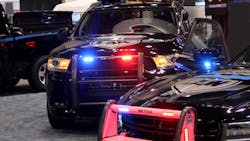IACP 2019: The Answers to Tomorrow's Challenges
This year, like so many others, when my team traveled to Chicago for the IACP conference, we were inundated by the hype about protesters, threats, etc. For those of you who have never been to IACP but anticipate going someday—ignore the hype. During our three days in Chicago, traveling back and forth from the hotel to McCormick Conference Center, not a single protester was observed. The shuttle service was efficient and comfortable and the conference was well coordinated.
The show floor stretched some 60 aisles (give or take a few) and you could find everything on display from software to helicopters. Of course there was also body armor, uniforms, weapons, communications devices and more. There were, in fact, so many “big” vendors with huge booths, it was almost easy to focus on them to the point of not seeing, or not noticing, some of the smaller ones. But some of the most interesting products were the single booth exhibitors.
Lt. Frank Borelli, Editorial Director
In one of the larger booths, Laser Technology Inc., there was information about a LIDAR product explained called TRU-Vision which uses their DBC Tailgating firmware. With over 35 years in law enforcement, I had never seen this before and would love to see it used far more often on every roadway.
Straight from their website: “This tailgating firmware validates violations by capturing the individual speed of two vehicles traveling in the same line and within close proximity of each other. The laser speed device then calculates the time and distance between the two moving vehicles. It’s the perfect aid for officers issuing tailgating violations, also known as a type of aggressive driving, and keeping our highways safe.” That’s something we need more of.
I found a set of in-ear hearing protection from OTTO Engineering Inc. With two types of earplug attachments (foam and rubber/silicone) to ensure a proper fit, these hearing protectors amplify low-decibel sound, reduce higher level decibel sound and completely remove high/damaging decibel level sound. They are delivered in a hard case not much bigger than a deck of cards and the case itself recharges the devices. The case reportedly only needs recharging every few months.
The HeartMath Institute was full of valuable information regarding heart health, heart rate variation and flexibility and how all of this can/might relate to stress levels/disorders. The importance of this information is how, if understood and learned early enough in a law enforcement career, it can reduce the potential long term stress and negative health impacts of our profession. One huge benefit to that is a reduced number of suicides.
There were plenty more small booths worth visiting but the two that every attendee should have made time for both offer trauma care products: Chinook and North American Rescue. Both brands have their own followings but the important thing is that, in the world of active shooter/killer response, while we’ve focused forever on fast entry and attacker neutralization, we have to include and expand our focus on trauma care for the casualties immediately after the scene is secured. That also includes being able to treat ourselves or our workmates.
CSI Hilary Romig, Editor
Arriving in Chicago, I had a slight idea of what to expect but held high anticipation of the unknown. All of my expectations were met in a positive way and several vendors caught my eye. Being part of a department gave me another level of appreciation for the products on exhibit.
Panasonic demoed their new software, Verify. The demonstration itself was impressive. I was taken into a room with a mock patrol car and told to sit in the driver’s seat. To the left of the windshield was a small, strategically placed screen that integrates head-up-display (HUD) technology. Located on the console was a four-button controller that offers information with a touch of a button. This includes access to the HUD, dispatch information, navigation, and license queries. Verify also includes voice activating license plate search software and is able to connect with a department’s CAD and RMS system. It is also equipped with the federated search query which allows officers the ability to search through other agency databases and will provide one report.
Each component of Verify provides updates on crucial information for the officer without compromising officer safety and maintaining situational awareness. A microphone with noise reduction capabilities reduces unwanted background noise. Along these lines, the voice-enabled license plate search provides officers a way to obtain needed information without taking their eyes off the road. Additionally, Verify has the ability to display warnings and alerts such as recent, activity and warrants. The system is able to work with rugged laptops including the latest TOUGHBOOK 55. I was also shown the new Arbitrator body camera which allows easy deployment, has a long battery life of up to 12 hours, and the ability to switch out individual batteries in order to prolong use.
I received a first-hand look at BallisticSearch and CrimeSearch at the Motorola Solutions and Vigilant Solutions booth. BallisticSearch and CrimeSearch are two new types of software that offer a quick solution to connecting physical evidence with crime, and a suspect (and any connected crimes) to particular regions.
BallisticSearch focuses on the shell casings that are found at a scene. Motorola and Vigilant Solutions teamed up with forensic tool marking and firearms experts along with former ATF agents to develop software that can quickly compare shell casings and expedite the collection of intel in a case. When shell casings are collected at a crime scene, there are often more than one, in fact, more often than not, there are numerous casings that may be from the same caliber of firearm. Ballistic Search allows an agency to magnify the shell casings for better observation and comparison. The software is then able to determine which casings have the most defined markings and would be ideal for further analysis. Once a match is potentially found, the agency can alert remote firearms experts that are part of their remote examining team. The expert can view the images and determine an outcome in a timely manner. This type of information may then be relayed to detectives quickly which can result in more intel or faster arrest. CrimeSearch utilizes the ballistic information as well as other information housed in an agency’s RMS system to detect patterns of crime by type, place, or evidence involved. These two softwares offer fast results and a large amount of crucial information. Since forensics is my specialty, I was fascinated by these two systems and greatly appreciated the introduction and demonstration of them.
The number of vendors, exhibitors, and law enforcement personnel was overwhelming but truly a unique experience. This year even included representation from other countries such as the United Kingdom and Dubai. Aside from the vendor hall, plenty of other activities were available for attendees. Chiefs and other law enforcement personnel were given options for classes, talks, and events such as Chief’s Night and other special dinners like the Blauer’s Ball put on by Blauer Uniform in order to thank some of their clientele. Networking options at IACP are endless and by changing the location of the event each year, allows for the chance of more connections for law enforcement and vendors alike. I’m looking forward to what next’s years IACP has in store.
Jonathan Kozlowski, Managing Editor
IACP is great at putting the high-tech devices available for officers on duty front and center. In my trip through the aisles, where else better to start than inside the patrol car.
With Alexa and Siri becoming more culturally accepted in the consumer market, the further adoption of voice recognition in law enforcement won’t be too far away. Nuance had their Dragon Law Enforcement software on demo. They like to say that wherever you have a cursor, you can use Dragon. It sounds simplistic, but based on the demo it actually is that straightforward. One of the bigger benefits of dictating is for officer safety keeping your face out of the screen and back into the world enhancing your situational awareness.
Samsung announced its new XCover Field Pro rugged smartphone. With a purposeful design for first responders, they placed a large PTT button on the side as well as a “man down” emergency button on top. These are red and look to be fairly easy to index with a finger. Additional features include a CJIS-standard fingerprint reader pad and three flashbulbs on the back to offer a redundant source of light. It may sound mundane, but one of the biggest standouts for me was they’re including a spare battery with purchase. Pair that with Ssamsung’s DeX to turn your phone into a mobile computer system from car to office.
But officers need not only smartphones and tablets. Companies are also working hard on making presumptive tests more convenient and user-friendly each year. A handful of companies had their handheld test kits on display – each with varying degrees of technology but all of them alleviate a significant amount of guesswork. On the higher end of tech, Abbott’s SoToxa roadside screening handheld device is small, lightweight, and very user-friendly to operate. It works by inserting the specially designed swab stick into an enclosed cartridge. The SoToxa handheld scans the test and displays easy-to-read digital results in five minutes or less. Results are captured and saved. Officers can then safely discharge the cartridge and discard as the sample is sealed inside. The device itself has a small footprint and takes very little room in a patrol vehicle or motorcycle.
DetectaChem’s system consists of one-time-use pouches but uses your smartphone with an app. Officers would swipe the sample onto the patch and scan it with the smartphone’s camera which is processed by the MobileDetect app. Each pouch is a one-time use and weighs merely ounces (if that).
With zero digital tech at all, SwabTek’s narcotics field test is basically of two parts: one a paper strip with dry reagent test zones and second, pre-treated swabs. SwabTek currently has field test kits available for cannabis, amphetamines, cocaine, heroin, dry explosives, and wet explosives. Fentanyl and nicotine kits will be available soon.
IACP had training sim options from one screen, two, three, four, five, and - with the gaining acceptance of virtual reality (VR)—none. VirTra announced an ultra-high-definition 300-degree simulator using five laser-based 4K projectors. The company’s Chairman and CEO Bob Ferris is quoted saying, “Research has demonstrated that the more accurately training simulations can reproduce lifelike situations, the more effective that training becomes.” The U.S. Department of Homeland Security’s Federal Law Enforcement Centers is first to receive the new simulator system, VirTra announced the purchase during the show.
Removing the screen altogether, some companies showcased VR. The tech is still young but the potential is clear. For example, earlier this year Axon announced their VR Empathy Training Program—a creative use of the technology stepping away from the use of force concept.
Both NSENA and Apex Officer had live demos where attendees were invited to jump into the virtual experience. Both utilize the commercial off-the-shelf Vive VR headset system, though Apex’s system included a backpack for haptic feedback. Much like training sims from companies like VirTra and MILO (Meggitt Training Systems), each scenario is controlled by the training officer selecting the reactions of the programmed characters. After-action review debrief software details the actions and analytics on the trainee.
Consumer VR controllers can be bulky and not exactly conducive to a realistic training experience. You’ll need special models of firearms and accessories. NSENA created a conversion kit to allow you to use your own rifle and shotgun.
The biggest drawback? You are wearing a helmet. It’s something you can forgive while in session as the immersion takes over your senses, but one you won’t forget.
Using their experience in RMS and case management software, CrimeCenter Software built a web (or cloud)-based case management system. The solution includes the features one would expect out of a CMS in 2019 and their Citizen Portal easily allows law enforcement to easily create and control a webpage to connect with the community. Oh, and act quick, the company provided a basic package of their software for free starting at the show until the end of the 2019 year.
Genetec’s Citigraf coordination response tool takes this to the next step proving crime data for “strategic decision support centers,” a clever name dubbed by the Chicago PD. Using an address or geographical area, with a few easy clicks, investigators would be able to see trends and any other related actional items from crimes to information from the digital evidence management system. Its criminal investigation tool, Valcri, gathers data from RMS, CAD as well as other systems to assist in mapping a case, analyze data collected, help find leads. Where the typical analyst would take three to five days, Genetec reports that Valcri can bring it down to two to three hours. Their ultimate goal: 20 minutes.
With a company that’s been around for 20+ years, also providing investigators with the tools they need, LexisNexis Risk Solutions’ Accurint Virtual Crime Center connects law enforcement with 10,000 public records as well as all connected agency data. Their demo basically sets you down a rabbit-hole of information where leads can be found instantly, collected, and analyzed. It’s only a three-year-old product, but a long-time solution.
If you’re looking for a conference that highlights the high-tech side of law enforcement, keep IACP as one of your choices—there are aisles and aisles of value. It’s also one of the shows that travel around the country. If you skipped IACP because you didn’t think it was worth the travel, the expense, the protesters (that seemed to not be there), rethink. It’s in New Orleans for 2020. You might want to check it out.


![Hillary Romig2019cropped 5d51aac790f8c[1] Hillary Romig2019cropped 5d51aac790f8c[1]](https://img.officer.com/files/base/cygnus/ofcr/image/2019/11/9x16/HillaryRomig2019cropped.5d51aac790f8c_1_.5dc08c0a7b3b1.png?auto=format,compress&fit=max&q=45&w=250&width=250)



